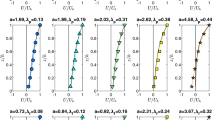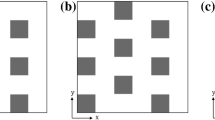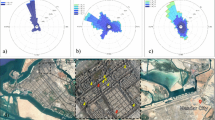Abstract
Average horizontal wind velocity in an urban canopy is mainly determined by a balance between flow deceleration caused by the drag force of buildings and flow acceleration from the momentum flux gradient in the canopy. To express the transport of momentum in an urban canopy, mixing length is often used to calculate diffusivity there. A new parametrization for mixing length is introduced for a one-dimensional multilayer urban canopy model (UCM). A database from large-eddy simulations using actual urban morphology for Tokyo is used for this parametrization. The derived mixing length is described as a function of the non-dimensional height raised to the power of \(q\), where \(q < 1\). The \(q\) value and constants of the function also depend on the selection of canopy height. The mixing length profile is closely related to that of the average plane area index of the buildings in the study area. Recalculation of mean horizontal wind velocity using the new parametrization of mixing length for Tokyo slightly improved the multilayer UCM results.









Similar content being viewed by others
References
Blackadar AK (1962) The vertical distribution of wind and turbulent exchange in neutral atmosphere. J Geophys Res 67:3095–3102
Castillo MC, Inagaki A, Kanda M (2011) The effects of inner and outer layer turbulence of a convective boundary layer in the near-neutral inertial sublayer over an urban-like surface. Boundary-Layer Meteorol 140:453–469
Coceal O, Belcher SE (2004) A canopy model of mean winds through urban areas. Q J R Meteorol Soc 130:1349–1372
Coceal O, Thomas TG, Castro IP, Belcher SE (2006) Mean flow and turbulence statistics over groups of urban-like cubical obstacles. Boundary-Layer Meteorol 121:491–519
Gambo K (1978) Notes on the turbulence closure model for atmospheric boundary layers. J Meteorol Soc Jpn 56:466–480
Grimmond CSB, Blackett M, Best MJ, Barlow J, Baik J-J, Belcher SE, Bohnenstengel SI, Calmet I, Chen F, Dandou A, Fortuniak K, Gouvea ML, Hamdi R, Hendry M, Kawai T, Kawamoto Y, Kondo H, Krayenhoff ES, Lee S-H, Loridan T, Martilli A, Masson V, Miao S, Oleson K, Pigeon G, Porson A, Ryu Y-H, Salamanca F, Shashua-Bar L, Steeneveld GJ, Tombrou M, Voogt J, Young D, Zhang N (2010) The international urban energy balance models comparison project: first results from phase 1. J Appl Meteorol Clim 49:1268–1292
Grimmond CSB, Blackett B, Best MJ, Baik J-J, Belcher SE, Beringer J, Bohnenstengel SI, Calmet I, Chen F, Coutts A, Dandou A, Fortuniak K, Gouvea ML, Hamdi R, Hendry M, Kanda M, Kawai T, Kawamoto Y, Kondo H, Krayenhoff ES, Lee S-H, Loridan T, Martilli A, Masson V, Miao S, Oleson K, Ooka R, Pigeon G, Porson A, Ryu Y-H, Salamanca F, Steeneveld GJ, Tombrou M, Voogt JA, Young DT, Zhang N (2011) Initial results from Phase 2 of the international urban energy balance model comparison. Int J Climatol 31:244–272
Ihara T, Genchi Y, Sato T, Yamaguchi K, Endo Y (2008) City-block-scale sensitivity of electricity consumption to air temperature and air humidity in business districts of Tokyo, Japan. Energy 33:1634–1645
Inagaki A, Castillo MC, Yamashita Y, Kanda M, Takimoto H (2012) Large eddy simulation study of coherent flow structures within a cubical canopy. Boundary-Layer Meteorol 142:207–222
Kanda M, Inagaki A, Miyamoto T, Gryschka M, Raasch S (2013) A new aerodynamic parametrization for real urban surfaces. Boundary-Layer Metetorol 148:357–377
Kawamoto Y, Ooka R (2009) Development of urban climate analysis model using MM5 Part 2—incorporating an urban canopy model to represent the effect of buildings. J Environ Eng 74:1009–1018
Kikegawa Y, Genchi Y, Yoshikado H, Kondo H (2003) Development of a numerical simulation system toward comprehensive assessments of urban warming countermeasures including their impacts upon the urban building’s energy-demands. Appl Energy 76:449–466
Kikegawa Y, Tanaka A, Ohashi Y, Ihara T, Shigeta Y (2014) Observed and simulated sensitivities of summertime urban surface air temperatures to anthropogenic heat in downtown areas of two Japanese Major Cities, Tokyo and Osaka. Theor Appl Climatol 117:175–193
Kondo H, Liu F-H (1998) A study on the urban thermal environment obtained through a one-dimensional urban canopy model. J Jpn Soc Atmos Environ 33:179–192 (in Japanese)
Kondo H, Kikegawa Y (2003) Temperature variation in the urban canopy with anthropogenic energy use. Pure Appl Geophys 160:317–324
Kondo H, Genchi Y, Kikegawa Y, Ohashi Y, Yoshikado H, Komiyama H (2005) Development of a multi-layer urban canopy model for the analysis of energy consumption in a big city: structure of the urban canopy model and its basic performance. Boundary-Layer Meteorol 116:395–421
Kondo H, Tokairin T, Kikegawa Y (2008) Calculation of wind in a Tokyo urban area with a mesoscale model including a multi-layer urban canopy model. J Wind Eng Ind Aerodyn 96:1655–1666
Kondo J, Akashi S (1976) Numerical studies on the two-dimensional flow in horizontally homogeneous canopy layers. Boundary-Layer Meteorol 10:255–272
Kusaka H, Kondo H, Kikegawa Y, Kimura F (2001) A simple single layer urban canopy model for atmospheric models: comparison with multi-layer and slab models. Boundary-Layer Meteorol 101:329–358
Lee S-H, Park S-U (2008) A vegetated urban canopy model for meteorological and environmental modelling. Boundary-Layer Meteorol 126:73–102
Leonardi S, Castro IP (2010) Channel flow over large cube roughness: a direct numerical simulation study. J Fluid Mech 651:519–539
Letzel MO, Krane M, Raasch S (2008) High resolution urban large-eddy simulation studies from street canyon to neighborhood scale. Atmos Environ 42:8770–8784
Martilli A, Clappier A, Rotach MW (2002) An urban surface exchange parametrization for mesoscale models. Boundary-Layer Meteorol 104:261–304
Martilli A, Santiago JL (2007) CFD simulation of airflow over a regular array of cubes. Part II: Analysis of spatial average properties. Boundary-Layer Meteorol 122:635–654
Maruyama T (1993) Optimization of roughness parameters for staggered arrayed cubic blocks using experimental data. J Wind Eng Ind Aerodyn 46–47:165–171
Mellor GL, Yamada T (1974) A hierarchy of turbulence closure models for planetary boundary layers. J Atmos Sci 31:1791–1806
Monin AS, Yaglom AM (1971) Statistical fluid mechanics: mechanics of turbulence, vol I. The MIT Press, Cambridge, 769 pp
Ohashi Y, Genchi Y, Kikegawa Y, Kondo H, Yoshikado H, Hirano Y (2007) Influence of air-conditioning waste heat on air temperature in Tokyo office areas during summer: numerical experiments using an urban canopy model coupled with a building energy model. J Appl Meteorol Climatol 46:66–81
Raasch S, Schröter M (2001) PALM—a large-eddy simulation model performing on massively parallel computers. Meteorol Z 10:363–372
Salamanca F, Martilli A, Tewari M, Chen F (2011) A study of the urban boundary layer using different urban parameterizations and high resolution urban canopy parameters with WRF. J Appl Meteorol Climatol 50:1107–1128
Tanaka S, Sugawara H, Narita K, Yokoyama H, Misaka I, Matsushima D (2011) Zero-plane displacement height in a highly built-up area of Tokyo. Sola 7:93–96
Thatcher M, Hurley P (2012) Simulating Australian urban climate in a mesoscale atmospheric numerical model. Bound-Layer Meteorol 142:149–175
Tokairin T, Kondo H, Yoshikado H, Genchi Y, Ihara T, Kikegawa Y, Hirano Y, Asahi K (2006) Numerical study on the effect of buildings on temperature variation in urban and suburban area in Tokyo. J Meteorol Soc Jpn 84:921–937
Watanabe T, Kondo J (1990) The influence of canopy structure and density upon the mixing length within and above vegetation. J Meteorol Soc Jpn 68:227–235
Xie Z-T, Coceal O, Castro IP (2008) Large-eddy simulation of flows over random urban-like obstacles. Boundary-Layer Meteorol 129:1–23
Yokoyama O, Gamo M, Yamamoto S (1979) The vertical profiles of turbulent quantities in the atmospheric boundary layer. J Meteorol Soc Jpn 57:264–272
Acknowledgments
This study was supported by the Research Program on Climate Change Adaptation, promoted by the Ministry of Education, Culture, Sports, Science and Technology of Japan.
Author information
Authors and Affiliations
Corresponding author
Rights and permissions
About this article
Cite this article
Kondo, H., Inagaki, A. & Kanda, M. A New Parametrization of Mixing Length in an Urban Canopy Derived from a Large-Eddy Simulation Database for Tokyo. Boundary-Layer Meteorol 156, 131–144 (2015). https://doi.org/10.1007/s10546-015-0019-7
Received:
Accepted:
Published:
Issue Date:
DOI: https://doi.org/10.1007/s10546-015-0019-7




